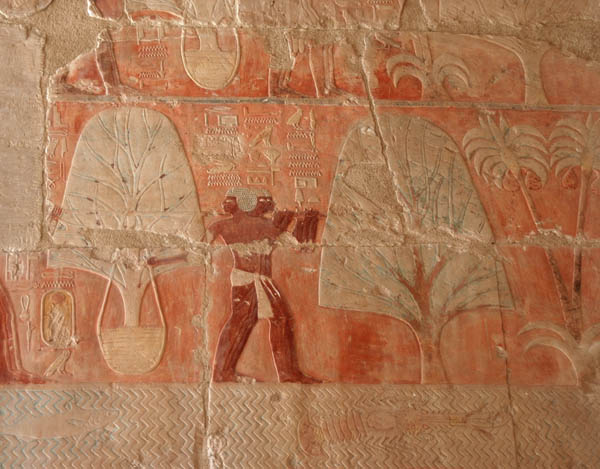
Antyu trees (a word that seems to indicate incense) with their root contained within baskets, and being transported to ships for their return to Egypt and re-planting at Hatshepsut's temple at Deir El-Bahri.
- The finest bas-reliefs of the temple of Hatshepsut are undoubtedly those that illustrate the famous naval expedition to the mysterious Land of Punt sent by the Queen, probably in the 8th year of her reign; they are situated in the southern portico of the second (intermediate) terrace. These polychrome reliefs accompanied by a text describe in detail the voyage to the shores of the Red Sea - called "Great Green" in the text, the arrival at punt of the Egyptian vessels, the indigenous pile dwellings, the plants and animals of the region, the sacrifices and presents offered to the King and ° Queen of Punt, the loading on board the vessels of important raw materials much needed by the Egyptians: cinnamon, aromatic wood, gold, resin, furs, but first of all antyu and senetjer (identified as myrrh and incense) as mentioned in the text describing the scene: "The vessels were loaded with large quantities of the wonders of the Land of Punt, with all the precious woods of the Land of God, heaps of gum of myrrh and living myrrh trees, with ebony wood and pure ivory, with the green gold of Amu, with aromatic wood called tyshepses and khesyt, with fragrances, incense, antimony, with baboons, monkeys and dogs, with skins of panthers of the South, with the natives and their sons..."
- After showing the return of the expedition to Thebes and the weighing of the imported goods, the bas-reliefs come to an end on the northern part of the portico by representing the arrival of the god Amun at Deir el-Bahri on the occasion of the Beautiful Feast of the Valley, to whom the Queen delivers a long speech stressing the valour of her enterprise that had made it possible to find the way to Punt in order to comply with the god's wish; they further feature the speech by Amun, the Lord of Karnak, who, having praised the Queen for all her actions and for the success of the expedition goes on to say that he was glad, since the precious goods from Punt confirmed he had created that land "to amuse his heart" and that he had provided for the final success of the difficult expedition, so that he could benefit from "all the good and beautiful things from the Land of God", satisfied that Hatshepsut had thus respected his will and honoured her divine father.
- It is known that 31 myrrh trees arrived in Egypt in good condition and were planted in Amun's garden at the Temple of Karnak, although different climatic conditions probably prevented them from taking root, which later induced Tuthmosis III and still later Ramesses III to organize new expeditions to Punt.
But where was the mysterious Land of Punt? The texts with the comments on various depicted scenes do not contain a hint about this; in any case, it is known that ever since the time of the Old Kingdom the Egyptians organized more or less regular expeditions to the Land of Punt, primarily with a view to importing incense and myrrh, the raw materials that could not be found elsewhere and were required for celebrating religious cults, in the course of which these substances were burnt in honour of the gods; they also found various use in the field of medicine, as evidenced by various papyri, such as Ebers or Harris 716. In particular, myrrh was principally used as a balsam, while incense, besides being burnt in special burners for its characteristic fragrance, was used in combination with other substances, such as honey, myrrh, wax, beer or fruit, for the treatment of numerous disorders from rheumatic pains to stomach-ache, and from liver disorders to problems of blood circulation and headaches.- As to the real geographical location of the Land of Punt, numerous hypotheses have been advanced and, although there is no reliable proof, it is logical to assume that Punt, which the ancient Egyptians called the "Land of God" was situated on the shores of the Red Sea. And indeed, knowing the relatively modest navigational skills of the ancient Egyptians, who were engaged in river navigation much more than in sea voyages, and comparing the average speed of the ships in that age which amounted to about 3-4 knots) to the time required for completing the expedition (about 30 to 40 days for the voyage along the coast using the dominant northerly winds and about three months for the return voyage on oars against the wind), it appears evident that the Land of Punt could not lie farther than Cape Guardafui, the southernmost point of the Red Sea. Besides, at these latitudes, on both the African and the Arabian coasts, the plants from which both myrrh and incense are produced, the Boswellia and the Commiphora, indeed grow. These were the two most important products of the Land of Punt; also, the examination of various archaeological objects brought from Punt demonstrates their African origin without the shadow of a doubt. Thus, it would be logical to assert that the Land of Punt was situated in the area of the Horn of Africa, more precisely, on the coasts of Ethiopia and northern Somalia.
